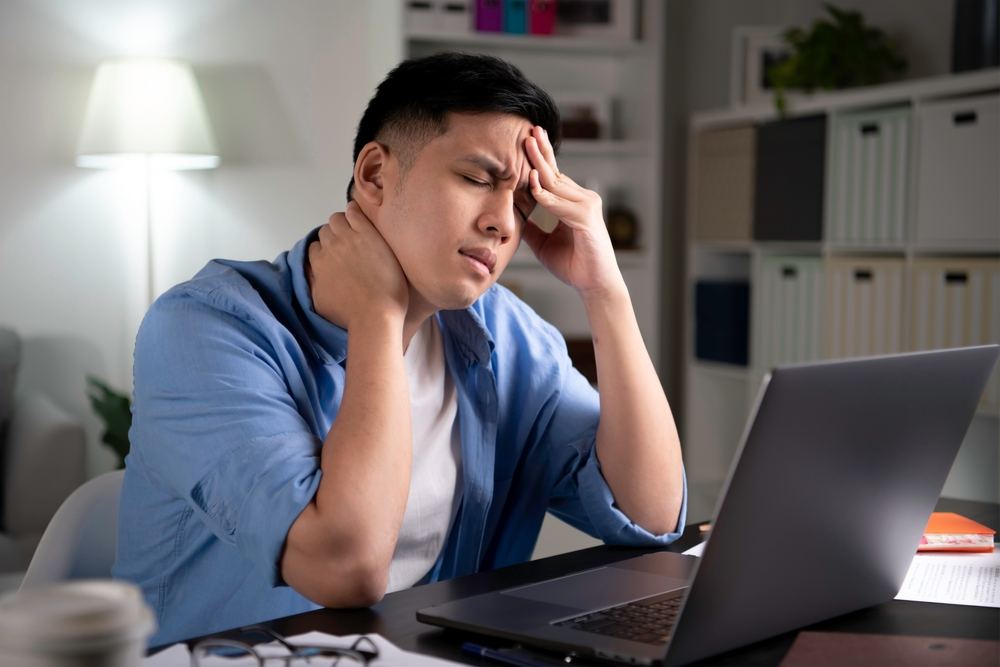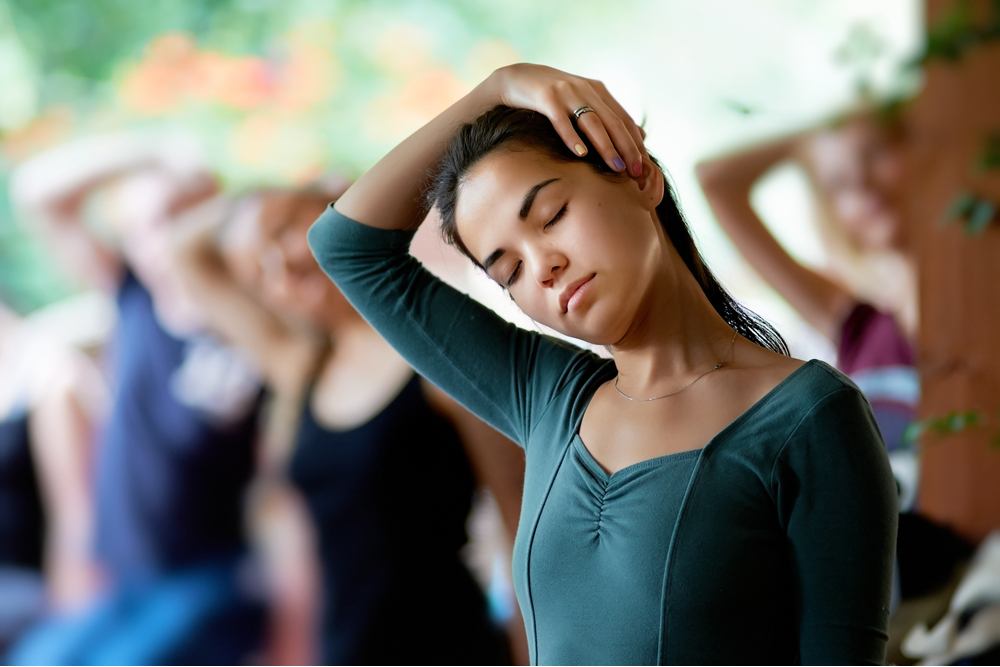 There is a reason people say that irritating things are a “pain in the neck” – such pain can be very annoying to deal with! Unfortunately, neck pain is a fairly common problem for adults. In 2018, a study found that 16% of adult respondents had experienced neck pain in the three months prior to being surveyed. Over time, that adds up to an estimation of 1 of every 3 adults experiencing some form of neck pain every year.
There is a reason people say that irritating things are a “pain in the neck” – such pain can be very annoying to deal with! Unfortunately, neck pain is a fairly common problem for adults. In 2018, a study found that 16% of adult respondents had experienced neck pain in the three months prior to being surveyed. Over time, that adds up to an estimation of 1 of every 3 adults experiencing some form of neck pain every year.
People suffer from a lot of different kinds of neck pain, including those caused by injury or chronic pain or illness. But from time to time, many adults experience a form of neck pain that does not always have a clear cause or appears to happen suddenly. Oftentimes, it is called a kink in the neck or a crick in the neck. Stiff neck is the term many medical professionals use.
Possible Causes of a Kink in Your Neck
 While a kink in your neck may seem random, there are a lot of potential causes for a sudden case of a stiff neck.
While a kink in your neck may seem random, there are a lot of potential causes for a sudden case of a stiff neck.
- Sleep position is one of the main culprits behind a sudden kink in the neck. You may wake up with a stiff neck in the morning after sleeping in an unfamiliar place, in a position your body is not used to, or in a way that causes undue strain on your neck muscles.
- Injury that causes your head to move too far to one side in a way that overextends the neck, such as an injury that occurs during a sport, can be another main reason behind stiff neck problems.
- Sports like swimming or certain jobs require constant repetitive motion of the head and neck.
- Many people who experience neck pain have jobs that require them to look at a computer or down at a phone for a long period of time. Poor posture can have a significant impact on neck health, as well as your back and shoulders.
- Stress and anxiety can cause tension in the neck and shoulders, leading to a kink in the neck.
Kinks in the neck can be annoying not only because of the pain itself, but because the ongoing pain can cause issues in other areas, especially sleep. Experts and common sense agree that long-term sleep disturbances can put you at a higher risk for a myriad of other health problems, including hypertension, diabetes, depression, and even stroke or heart attack. Don’t wait for that pain in the neck to go away – do something about it!
Neck Kink Relief
Managing the pain from a kink in the neck is relatively easy to do at home. A combination of simple treatments and specific stretches can go a long way. However, if your attempts to manage the pain at home do not seem to be working, you may need to seek more intensive neck pain treatment with support from a medical professional. After the kink in your neck has gone away, you can also consider doing strengthening exercises for your neck, shoulders, and back, especially if this is a recurring problem for you.
At-Home Remedies
Most of the following remedies are things that are easy to execute at home for little to no cost.
Temperature
Any time you sustain an injury to your muscles, it is a good idea to use ice to help reduce swelling and help you find relief from the pain. Doctors recommend applying ice to the affected shoulder for twenty minutes every three to four hours, for the first 48 to 72 hours (2-3 days) after you notice your injury.
After those first few days of using ice, you can transition to using heat to manage the pain. You can do this in a variety of ways. Some people find that simply implementing more frequent hot showers can do the trick; others apply heating pads to the area of their neck that is experiencing pain.
When using temperature to manage pain, be sure not to leave the ice or heat on your skin for too long. It is especially important not to fall asleep because you could suffer frostbite, burns, or other issues with your skin.
Over-the-Counter Medication
Easily accessible painkillers available over the counter at a local pharmacy should be strong enough to help you with any pain you may be experiencing. The most frequently doctor-recommended forms of pain medication are non-steroidal anti-inflammatory drugs, or NSAIDs. Examples include ibuprofen, acetaminophen, or aspirin. Anything that targets inflammation will help reduce pain, as inflammation is usually accompanied by pain.
Be careful to follow the directions on the bottle or package when using NSAIDs, or any medication. In the case of NSAIDs, improper use or overuse can lead to significant health problems, especially liver damage. Be sure to stay hydrated while you are using an NSAID to help limit your chance of risk.
Gentle Movement
When you have a kink in the neck, you may be tempted to move your neck as little as possible. That makes sense and is recommended for a short period after you first experience the pain, but an extended period of immobility after a muscle injury can actually make your recovery last longer.
The best way to combat this effect is to use gentle movement to keep your neck and shoulders moving. Start slow, after a few days of rest. Avoid painful, jerking, or over-repetitive movement. You may want to discuss with a physical therapist before getting started, as they can recommend the best options for optimal treatment.
Gentle Massage
Just as with movement, the key to massaging a kink in the neck is to be gentle. You can have a partner or friend gently massage sore or painful areas. Remember to communicate clearly what you need. Discuss beforehand how much pressure you want and the kinds of massages you may already know feel good for you. Continue communicating during the massage to let the person massaging you know when their attempts are helpful or when they hurt.
Stretches
There are a few simple stretches that can be helpful to do each morning and night to help with a kink in the neck. Gentle exercises that help you regain your range of motion are particularly helpful. You can roll your shoulders backward and then forward, or gently tilt your head to one side, letting gravity make use of the weight of your head, before switching to the other.
Additionally, there are a few exercises that physical therapy experts recommend to help recover from a kink in the neck. While their names may seem complex, the exercises themselves are simple. The word “cervical” refers to the neck column.
Cervical Flexion Stretch
- Breathe evenly throughout the exercise.
- Slowly look down at the floor, remembering to breathe. Stay there for a count of thirty to sixty seconds.
- Return to center. Don’t rush!
- Do not go past the range of motion in which you feel the least pain. If you do begin to feel pain, you have gone too far and may need to rest.
Cervical Lateral Flexion Stretch
- Breathe evenly throughout the exercise. Focus on your breath to make sure you retain control over the exercise.
- Put your right arm behind your back. This should be gentle.
- Slowly tilt your head to the left as far as you feel comfortable. You can use your hand to add extra weight but allow gravity to do the main work of the stretch. Remain in this position for up to 60 seconds.
- Return to center. Remember to move slowly and in a controlled manner.
- Now, try with your left arm behind your back and your right ear moving towards the shoulder.
Cervical Rotation Stretch
- Breathe slowly and evenly.
- On the inhale, turn your head slowly to the right as if trying to look over your shoulder.
- Hold the stretch for 30 to 60 seconds.
- Return your gaze to center.
- Do the same thing by turning your head slowly to the left.
Do not attempt to extend your muscles beyond what you feel comfortable with. If you feel pain, you should stop.
Preventing a Kink in Your Neck
 There are lifestyle changes you can make to help reduce your chances of waking up in the morning with a kink in the neck, especially if this is something that seems to happen to you frequently.
There are lifestyle changes you can make to help reduce your chances of waking up in the morning with a kink in the neck, especially if this is something that seems to happen to you frequently.
Sleep Position
The position in which you sleep is one of the most common reasons that you might wake up with a stiff neck. Doctors recommend never sleeping on your stomach and always sleeping on your side or back, especially with the use of pillows to help keep you supported. When you sleep on your stomach, your head is turned to one side or the other for an extended period of time, leading to overextension and pain.
Posture
When you are using a computer or phone or when you are driving, be mindful of your posture. Your gaze should be mostly straight ahead, with your feet on the floor. Take frequent breaks and make sure not to lean your neck too far forward.
Stress Relief
Taking measures to relieve stress in your life can also make a big difference in the frequency of incidences of neck pain. Be sure to eat a balanced diet and exercise for at least thirty minutes three times a week. Spend time outdoors as much as you can, and stay in touch with loved ones that you trust.
